Potrebujeme váš súhlas na využitie jednotlivých dát, aby sa vám okrem iného mohli ukazovať informácie týkajúce sa vašich záujmov. Súhlas udelíte kliknutím na tlačidlo „OK“.
ASTM E1802-12
Standard Test Methods for Wet Insulation Integrity Testing of Photovoltaic Modules
Automaticky preložený názov:
Štandardné skúšobné metódy pre Wet izolačného Integrity testovanie fotovoltaických modulov
NORMA vydaná dňa 1.12.2012
Informácie o norme:
Označenie normy: ASTM E1802-12
Poznámka: NEPLATNÁ
Dátum vydania normy: 1.12.2012
Kód tovaru: NS-43104
Počet strán: 3
Približná hmotnosť: 9 g (0.02 libier)
Krajina: Americká technická norma
Kategória: Technické normy ASTM
Kategórie - podobné normy:
Anotácia textu normy ASTM E1802-12 :
Keywords:
dielectric voltage withstand, electrical testing, energy, insulation integrity, insulation resistance, modules, photovoltaics, solar, ICS Number Code 27.160 (Solar energy engineering)
Doplňujúce informácie
| Significance and Use | ||||
|
4.1 The design of a photovoltaic module or system intended to provide safe conversion of the sun's radiant energy into useful electricity must take into consideration the possibility of hazard should the user come into contact with the electrical potential of the module or system. In addition, the insulation system provides a barrier to electrochemical corrosion, and insulation flaws can result in increased corrosion and reliability problems. These test methods describe procedures for verifying that the design and construction of the module provides adequate electrical isolation through normal installation and use. At no location on the module should the PV generated electrical potential be accessible, with the obvious exception of the output leads. This isolation is necessary to provide for safe and reliable installation, use, and service of the photovoltaic system. 4.2 This test method describes a procedure for determining the ability of the module to provide protection from electrical hazards. Its primary use is to find insulation flaws that could be dangerous to persons who may come into contact with the module, especially when modules are wet. For example, these flaws could be small holes in the encapsulation that allow hazardous voltages to be accessible on the outside surface of a module after a period of high humidity. 4.3 Insulation flaws in a module may only become detectable after the module has been wet for a certain period of time. For this reason, these procedures specify a minimum time a module must be immersed prior to the insulation integrity measurements. 4.4 Electrical junction boxes attached to modules are often designed to allow liquid water, accumulated from condensed water vapor, to drain. Such drain paths are usually designed to permit water to exit, but not to allow impinging water from rain or water sprinklers to enter. It is important that all surfaces of junction boxes be thoroughly wetted by spraying during the tests to enable these protective drain features to be properly tested. Therefore, drain holes should not be plugged or otherwise protected. 4.5 These procedures may be specified as part of a series of qualification tests involving performance measurements and demonstration of functional requirements. Because insulation leakage resistance and insulation current leakage are strong functions of module dimensions, ambient relative humidity, absorbed water vapor and other factors, it is the responsibility of the user of these test methods to specify the minimum acceptable leakage resistance. |
||||
| 1. Scope | ||||
|
1.1 These test methods provide procedures to determine the insulation resistance of a photovoltaic (PV) module, i.e. the electrical resistance between the module's internal electrical components and its exposed, electrically conductive, non-current carrying parts and surfaces. 1.2 The insulation integrity procedures are a combination of wet insulation resistance and wet dielectric voltage withstand test procedures. 1.3 These procedures are similar to and reference the insulation integrity test procedures described in Test Methods E1462, with the difference being that the photovoltaic module under test is immersed in a wetting solution during the procedures. 1.4 These test methods do not establish pass or fail levels. The determination of acceptable or unacceptable results is beyond the scope of these test methods. 1.5 The values stated in SI units are to be regarded as standard. No other units of measurement are included in this standard. 1.6 This standard does not
purport to address all of the safety concerns, if any, associated
with its use. It is the responsibility of the user of this standard
to establish appropriate safety and health practices and determine
the applicability of regulatory limitations prior to use.
Standard Test Methods for Insulation
Integrity and Ground Path Continuity of Photovoltaic Modules Standard Terminology of Solar Energy
Conversion |
Podobné normy:
Historická
1.11.2013
Historická
1.4.2009
Historická
1.3.2012
Historická
1.6.2010
Historická
1.12.2012
Historická
1.4.2009


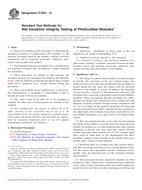
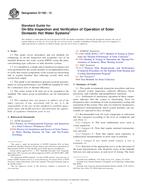 ASTM E1160-13
ASTM E1160-13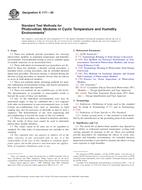 ASTM E1171-09
ASTM E1171-09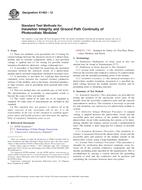 ASTM E1462-12
ASTM E1462-12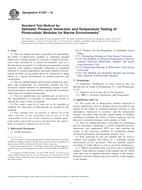 ASTM E1597-10
ASTM E1597-10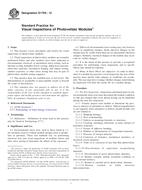 ASTM E1799-12
ASTM E1799-12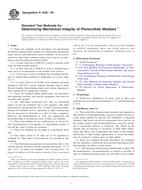 ASTM E1830-09
ASTM E1830-09
 Cookies
Cookies
